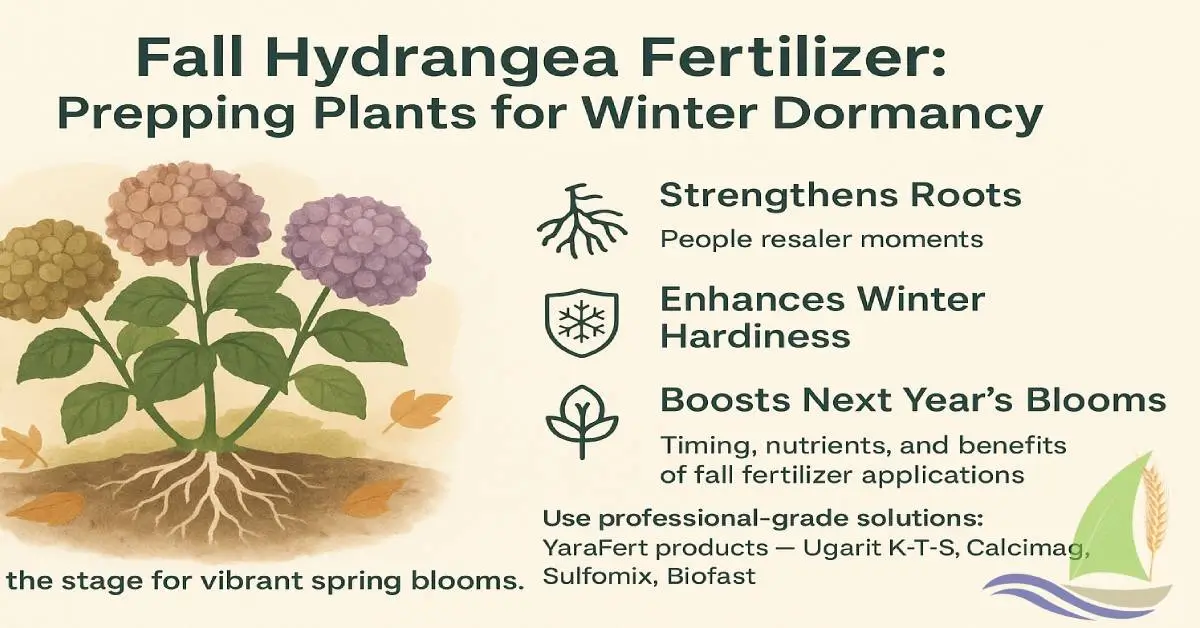Hydrangeas are among the most cherished garden shrubs, offering lush blooms through summer and early fall. But to ensure they return healthy and vibrant in spring, gardeners must pay close attention to fall feeding. The right hydrangea fertilizer at the end of the growing season strengthens roots, enhances winter hardiness, and sets the stage for next year’s blooms.
This comprehensive guide explores the timing, nutrient composition, and benefits of fall applications. We’ll also highlight how professional-grade solutions like YaraFert products—including Ugarit K-T-S, Calcimag, Sulfomix, and Biofast—help optimize hydrangea health during the transition to dormancy.
Final Hydrangea Fertilizer Application Timing in Fall
Timing is critical when applying hydrangea fertilizer in autumn. The goal is to provide nutrients that encourage root development and cold tolerance without stimulating new vegetative growth, which could be damaged by frost.
- Best window: Late September to mid-October, depending on your region. Apply fertilizer after blooming has ended but before the soil freezes.
- Avoid late feeding: Fertilizing too close to winter may push soft, green growth that won’t harden off in time.
- Soil temperature factor: Fertilizer uptake is most effective when soil is still above 50°F (10°C).
Products like Ugarit Multi (30% K?O, 32% S, 10% CaO) provide the potassium and calcium hydrangeas need during this stage, reinforcing tissues before winter.
Choosing Low-Nitrogen Fall Formulas
Hydrangeas in fall need less nitrogen and more potassium and phosphorus. Excess nitrogen encourages leafy shoots, which are highly vulnerable to frost damage.
When selecting a hydrangea fertilizer for autumn, look for:
- Low nitrogen content: N levels at or below 10%.
- Moderate phosphorus: Supports root metabolism and energy transfer.
- High potassium: Strengthens stems and bud tissues for winter survival.
Examples of suitable formulas include:
- Ugarit 0-5-65 ? 65% K?O, excellent for late-season potassium enrichment.
- Super DKP (30% P?O?, 60% K?O) ? balances phosphorus and potassium for strong roots.
- Ugarit 10-0-5 + 70% Organic Matter ? provides organic support with only modest nitrogen.
By choosing the right low-nitrogen formulas, gardeners can prevent vulnerable new growth while still strengthening root reserves.
read more: How to Fertilize Mature Hydrangeas Without Damaging Roots
Benefits of Potassium in Fall Hydrangea Fertilizer

Potassium (K) is often called the “quality nutrient,” and in fall, it becomes indispensable for hydrangeas. This macronutrient enhances resilience against stress factors like cold, drought, and disease.
Here’s why potassium should dominate fall hydrangea fertilizer formulations:
- Cell wall strengthening: Potassium contributes to lignin synthesis, thickening cell walls and reducing freezing injury.
- Osmoregulation: Helps regulate water movement, preventing desiccation during dry winter winds.
- Carbohydrate transport: Facilitates movement of sugars into roots, ensuring adequate energy storage for dormancy.
- Flower bud protection: Supports bud scales, improving the likelihood of spring blooms.
Premium options like Ugarit K-T-S 25 (36% K?O, 25% SO?) and Ugarit K-T-S 70 (36% K?O, 70% SO?) not only provide potassium but also sulfur, which enhances nutrient uptake and improves soil conditions.
How Fall Fertilizer Supports Root Hardiness
The unseen part of hydrangeas—the root system—determines how well they survive the winter. While top growth slows down in fall, roots remain active until the soil cools completely. A carefully selected hydrangea fertilizer supports this crucial phase.
Fall root benefits include:
- Enhanced carbohydrate storage: Phosphorus-rich fertilizers like Ugarit DKP (33% P?O?, 44% K?O) fuel root respiration and sugar storage.
- Improved nutrient absorption: Organic formulations such as Biofast Gel (12-12-12 with humic/fulvic acids) improve soil microbial activity, supporting long-term fertility.
- Micronutrient reinforcement: Products like Sulfomix (Fe 6%, Zn 3%, MgO 3%, Mn 2%, Cu 2%, B 3%) address trace element needs that directly influence winter root metabolism.
By focusing on root health in fall, you’re effectively building a foundation for spring vitality.
READ MORE: Spring Hydrangea Fertilizer Schedule: Boosting Early Growth
Avoiding Cold Damage With Proper Fertilizer Scheduling

Cold damage to hydrangeas often occurs not only from extreme temperatures but also from improper nutrient balance. Applying the wrong fertilizer at the wrong time can inadvertently weaken plants.
To minimize risk, follow these best practices for fall hydrangea fertilizer use:
- Stop high-nitrogen feeding after midsummer. Shift to potassium-dominant blends by September.
- Incorporate calcium and magnesium sources. Products like Calcimag (15% N, 22% CaO, 3% MgO, 0.5% B) strengthen cell structures, reducing winter dieback.
- Apply fertilizers evenly around the drip line. This ensures nutrients reach the active feeder roots.
- Water deeply after application. Moisture carries nutrients into the root zone and reduces salt stress.
By sticking to a structured fertilizer schedule, you can help your hydrangeas transition smoothly into dormancy without unnecessary cold stress.
Practical Product Application Guide
For gardeners seeking a simplified plan, here’s a seasonal breakdown of fall fertilizer use with YaraFert solutions:
| Growth Stage (Fall) | Nutrient Focus | Recommended Products | Key Benefits |
|---|---|---|---|
| Post-bloom (Sept) | Root energy + micronutrients | Biofast, Sulfomix | Balanced feeding + trace elements |
| Early dormancy (Oct) | Potassium + phosphorus | Ugarit DKP, Super DKP | Root hardiness + bud protection |
| Pre-winter (Late Oct) | Potassium + calcium | Ugarit Multi, Calcimag | Strengthened tissues + cold resistance |
This type of targeted application ensures that hydrangeas receive exactly what they need as they prepare for dormancy.
Conclusion: Preparing Hydrangeas for a Strong Spring
Fall fertilization is one of the most important steps in long-term hydrangea care. The right hydrangea fertilizer—applied at the right time—prevents frost damage, strengthens roots, and lays the groundwork for abundant blooms next year.
Professional solutions like Ugarit 0-5-65, Super DKP, Calcimag, Biofast, and Sulfomix give growers and gardeners a reliable way to address both macronutrient and micronutrient needs during this crucial period.
Ready to give your hydrangeas the best start for spring? Explore our complete range of YaraFert hydrangea fertilizer solutions tailored to fall applications. Contact our team today for personalized guidance, or visit our website to learn more about building a season-long nutrition program for your garden.
READ MORE: Summer Feeding Tips for Healthy Hydrangea Blooms

